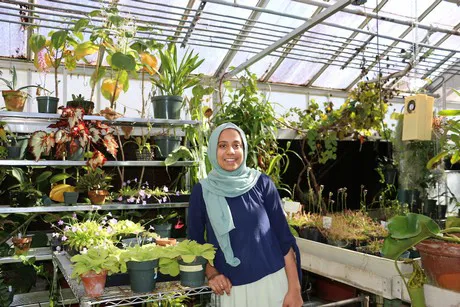It all started with a movie many people haven’t seen.
About 10 years ago, Ruqayah Bhuiyan sat down to watch “Sunshine,” a movie about astronauts flying to the sun. Amid all of the high drama, fission bombs and personal conflict aboard the ship, there was a garden.
This outer-space garden got her thinking, “If you can grow plants in space, couldn’t they grow anywhere?”
Today Bhuiyan is a senior studying horticulture in the University of Georgia College of Agricultural and Environmental Sciences. She’s interested in controlled and low-resource farming systems. But her goals for controlled growing systems are more earthbound than the space garden in the movie. She wants to produce more food using less resources for people in environmentally restricted parts of the world.
This spring, she was able to meld science with science fiction by interning with NASA at the Kennedy Space Center in Florida.

Seeing technology that seems like something from the future applied to real problems was a great exercise in imagining all of the factors that go into growing food in a controlled environment on Earth.
“My goal going into this was to learn how to grow more plants with limited resources and in a practical way,” Bhuiyan said. “They need this food for extended and long-distance space travel. They need this food for going to Mars.”
During her four months on the Space Coast, Bhuiyan put her experiments in controlled environments into overdrive.
Her primary experiment involved testing different types of leafy green vegetables to see which would produce the most fresh matter and grew the best under similar conditions set on the International Space Station.
NASA provided the experimental concept and space, and Bhuiyan maintained and recorded observations of the growth responses of each variety tested during the course of the trials.
She and her mentor, Michelle Spencer, tested 16 crops and ran three trials for each crop. In the end, ‘Extra-Dwarf’ pak choy and ‘Dragoon’ lettuce came out on top. Those varieties will be sent up to the International Space Station for space flight testing in the next round of experiments.
Supervisors also provided Bhuiyan with the space and equipment to run experiments in aeroponics — where plants’ bare roots are misted with water and nutrients — and cable culture — where plants are preseeded into spools of coiled plastic channels and unfurled when the astronauts reach their destination.
She even got to do an experiment growing potatoes, à la Matt Damon in “The Martian.” It was nearly as dramatic growing them in Florida, she said.
This fall, Bhuiyan will continue her undergraduate research work with Professor Marc van Iersel in the CAES Department of Horticulture, and she’s going to continue to run small-scale experiments for NASA.
If you’re going to farm in outer space, many little things have to be just right. Bhuiyan knows that those details will make a difference, whether the farmers that she helps are 2,000 miles west of Athens or 2,000 miles above it.
“Going (to the space center) and actually witnessing what can be done, then coming back to Athens, (Georgia), and seeing the potential within the ag world was really impactful,” she said.
